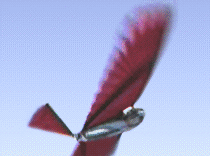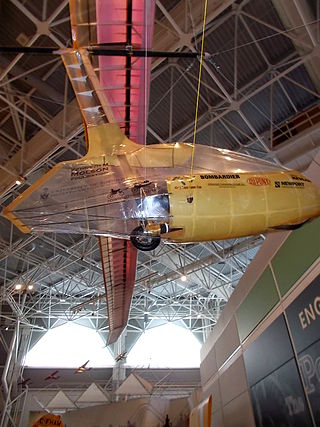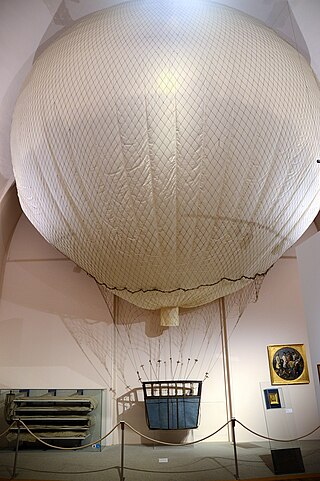
An aircraft is a vehicle that is able to fly by gaining support from the air. It counters the force of gravity by using either static lift or the dynamic lift of an airfoil, or, in a few cases, direct downward thrust from its engines. Common examples of aircraft include airplanes, helicopters, airships, gliders, paramotors, and hot air balloons.

Aeronautics is the science or art involved with the study, design, and manufacturing of air flight–capable machines, and the techniques of operating aircraft and rockets within the atmosphere. The British Royal Aeronautical Society identifies the aspects of "aeronautical Art, Science and Engineering" and "The profession of Aeronautics ."

An airship or dirigible balloon is a type of aerostat or lighter-than-air aircraft that can navigate through the air under its own power. Aerostats gain their lift from a lifting gas that is less dense than the surrounding air.

The history of aviation extends for more than two thousand years, from the earliest forms of aviation such as kites and attempts at tower jumping to supersonic and hypersonic flight by powered, heavier-than-air jets.

An ornithopter is an aircraft that flies by flapping its wings. Designers sought to imitate the flapping-wing flight of birds, bats, and insects. Though machines may differ in form, they are usually built on the same scale as flying animals. Larger, crewed ornithopters have also been built and some have been successful. Crewed ornithopters are generally either powered by engines or by the pilot.

The Fédération aéronautique internationale is the world governing body for air sports, and also stewards definitions regarding human spaceflight. It was founded on 14 October 1905, and is headquartered in Lausanne, Switzerland. It maintains world records for aeronautical activities, including ballooning, aeromodeling, and unmanned aerial vehicles (drones), as well as flights into space.
This is a list of aviation-related events during the 19th century :
The National Aeronautic Association of the United States (NAA) is a non-profit 501(c)(3) organization and a founding member of the Fédération Aéronautique Internationale (FAI). Founded in 1905, it is the oldest national aviation club in the United States and one of the oldest in the world, it serves as the “Aeroclub of the United States” and, by its Mission Statement it is "…dedicated to the advancement of the art, sport and science of aviation in the United States.” The NAA is headquartered at the Ronald Reagan Washington National Airport, in Washington, D.C.

Early flying machines include all forms of aircraft studied or constructed before the development of the modern aeroplane by 1910. The story of modern flight begins more than a century before the first successful manned aeroplane, and the earliest aircraft thousands of years before.

A hybrid airship is a powered aircraft that obtains some of its lift as a lighter-than-air (LTA) airship and some from aerodynamic lift as a heavier-than-air aerodyne.

This listing of flight altitude records are the records set for the highest aeronautical flights conducted in the atmosphere, set since the age of ballooning.

Blériot Aéronautique was a French aircraft manufacturer founded by Louis Blériot. It also made a few motorcycles between 1921 and 1922 and cyclecars during the 1920s.
The UTIAS Ornithopter No.1 is an ornithopter that was built in Canada in the late 1990s. On 8 July 2006, it took off under its own power, assisted by a turbine jet engine, making a flight of around 300 metres that lasted 14 seconds.

In aeronautics, a flexible wing is an airfoil or aircraft wing which can deform in flight.

A human-powered aircraft (HPA) is an aircraft belonging to the class of vehicles known as human-powered transport.

The Snowbird is a human-powered ornithopter that was built as a project of the University of Toronto Institute for Aerospace Studies (UTIAS). Snowbird was the first human-powered ornithopter to fly straight and level.

Great Lakes Gliding Club (GLGC) is a soaring club located at Tottenham/Ronan Aerodrome, 56.9 km northwest of Toronto, Ontario, Canada.

The pioneer era of aviation was the period of aviation history between the first successful powered flight, generally accepted to have been made by the Wright Brothers on 17 December 1903, and the outbreak of the First World War in August 1914.

Chalais-Meudon is an aeronautical research and development centre in Meudon, to the south-west of Paris. It was originally founded in 1793 in the nearby Château de Meudon and has played an important role in the development of French aviation.















